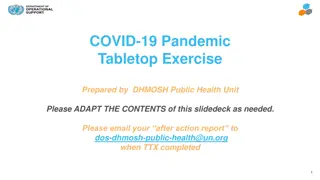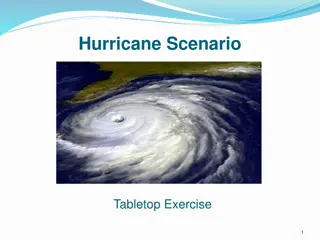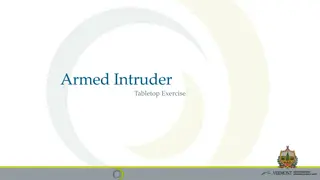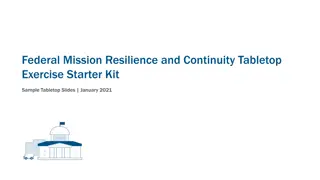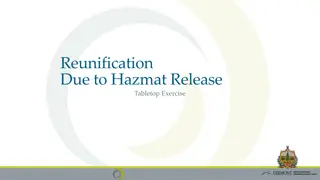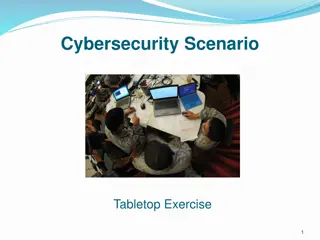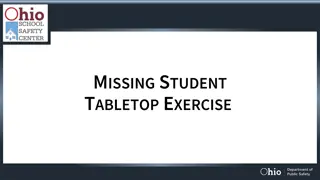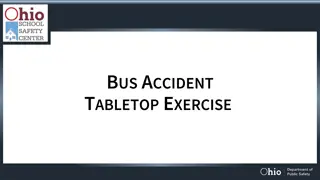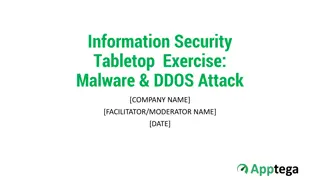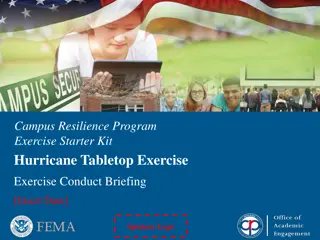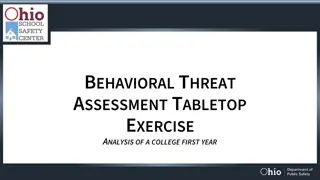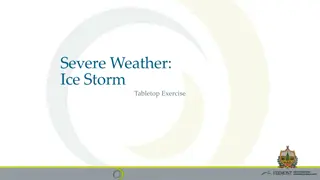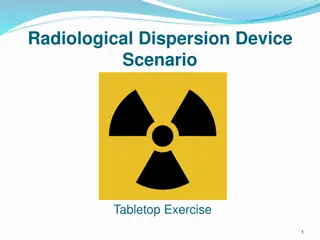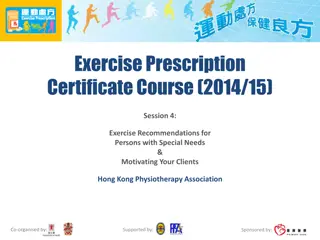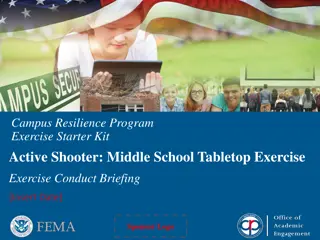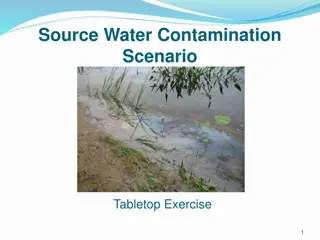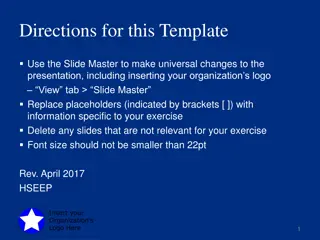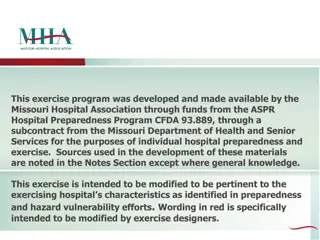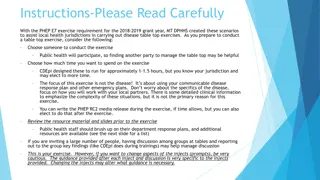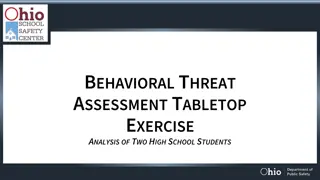Threat Assessment Tabletop Exercise Overview
Conducting a tabletop exercise focused on threat assessment in a school setting. The exercise agenda includes welcome, introductions, exercise goals, objectives, participants' roles, exercise structure, and rules. The goals are to test preparedness for potential threats, coordinate plans effectively, strengthen partnerships, identify areas for improvement, and develop corrective action plans. The exercise involves evaluating risks, testing threat assessment protocols, clarifying different threat categories, and engaging in scenario-driven discussions to enhance response strategies.
Download Presentation

Please find below an Image/Link to download the presentation.
The content on the website is provided AS IS for your information and personal use only. It may not be sold, licensed, or shared on other websites without obtaining consent from the author. Download presentation by click this link. If you encounter any issues during the download, it is possible that the publisher has removed the file from their server.
E N D
Presentation Transcript
Threat Assessment Tabletop Exercise
Exercise Agenda Welcome and Introductions Housekeeping Exercise Overview Goals Rules Objectives/Core Capabilities Assumptions and Artificialities Roles and Responsibilities Schedule Structure Scenario-Driven Exercise Facilitated Discussion in Four Modules Hot Wash Closing Comments Debrief
Welcome and Introductions Opening Remarks Facilitator Introductions Hosting Agency Participants Exercise Staff Lead Facilitator
Exercise Goals Test plans to prepare for, respond to, and recover from a potential threat in our school. Ensure effective coordination of plans and actions with school and community partners. Strengthen relationships with our response partners. Identify areas for improvement and develop a corrective action plan.
Objectives and Core Capabilities To evaluate the risk posed by a student, staff member or another person, by a structured, trained team, in response to an actual or perceived threat or concerning behavior. To test the development and use of a threat assessment protocol as one element in the school s broad strategy to prevent violence in the schools. For the purposes of clarifying a threat of an attack against a school; threats are placed into two categories: 1) Internal or 2) External.
Participants Roles and Responsibilities Players: Respond to the situation presented, based on expert knowledge of response procedures, current plans and procedures, and insights derived from training. Facilitator(s): Responsible for moderating and keeping participant discussions focused on exercise objectives and core capabilities, and ensuring relevant issues are explored; provide situational updates and additional information; resolve questions as required.
Exercise Structure A scenario-driven, facilitated discussion-based exercise The exercise is divided in four modules: Module 1: Initial Response Scenario Background Module 2: Response Scenario Update #1 Module 3: Response Scenario Update #2 Module 4: Recovery Scenario Update #3 Debrief
Rules for Players There are no right or wrong answers/ideas. Varying viewpoints are expected and will be respected. Exercise decisions are not precedent setting. Players are encouraged to consider different approaches and suggest improvements/ Think outside the box.
Ground Rules This is not a test of current capabilities and plans. It is a discussion of probable responses to a hypothetical emergency. The exercise will be an open dialogue. All ideas and input are welcome. One person speaks at a time. The scenario will be accepted as is. However, the facilitator may make modifications as deemed appropriate. No hypothetical resources are available.
Assumptions and Artificialities The exercise is conducted in a no-fault learning environment wherein capabilities, plans, systems and processes will be evaluated. Participants respond to the TTX scenario events and other exercise information from the perspective of their school s current policies, plans, processes and capabilities. The exercise scenario is plausible, and events occur as they are presented in the TTX scenario, allowing for artificialities. All players receive information at the same time.
Exercise Schedule Exercise Logistics and Set-up Registration Welcome and Introductions Exercise Overview Module 1: Initial Response Scenario Background Break Module 2: Response Module 3: Recovery Break Hot Wash Closing Comments Debrief
Tabletop Processes A scenario and update statements will be used to generate discussion of probable response actions. Participants will provide situational responses based on established procedures and plans. The Emergency Operations Plan (should be) available for reference. Other than maps and diagrams, no additional materials will be provided. The exercise will conclude with development of action steps needed to support future mitigation and preparedness efforts.
Exercise Guidelines Respond based on your knowledge of your school plans and capabilities. Discuss and present multiple options and possible solutions. Be aware that each phase will not have complete resolution. Any issues that cannot be resolved within a reasonable period of time will be tabled as an after-action item. If more information is needed, ask. Assume any agencies that are requested are initiating their response plans.
Module 1 Initial Response: Scenario Background
Date: Time: It is a Wednesday morning and many students are overheard discussing the Snapchat a classmate sent Tuesday evening. The school administration has become aware that a student posted pictures of guns in her home and pictures of herself holding the weapons. The student also wrote threatening messages and identified her targets by name.
Discussion Based on the information you have received what are your first steps in responding to this information? Do you have a Multidisciplinary Threat Assessment Team in your school? Do you have a policy that defines the roles and responsibilities for your behavioral Threat Assessment Team? Do you have a formal process that you have shared with your faculty staff and student population on how to report concerning behaviors, social media posts, or conversations that may have a negative impact on your school? How do you determine the threshold for law enforcement intervention in instances such as this? Is there an imminent situation or a need for the team to call for immediate law enforcement intervention?
Module 2: Response
Date: Time: Officers have responded to the school to investigate and have subsequently placed the student in custody. A copy of the Columbine book by Dave Cullen was found in her backpack along with a list of student names and explicit diagrams. As the student was removed from the school she was overheard repeatedly shouting, I am not going to be stopped. My plans are already in motion.
Discussion Based on the information provided, what is the first step the Behavioral Threat Assessment Team (BTAT) should take? Is there a need for the team to gather information? If so, what type of information will you look for? Where should the team look for information? Is there information that would be helpful to the team that may be restricted, and if so, what options exist for obtaining that information? What notifications need to be made? Community Parents Students Media
Module 3: Response - Scenario Update
Date: Time: Many individuals have come forth with information about the student and her behaviors in the past months. The student has been identified by the BTAT in the past, but the school has found limited support from her family in requesting she seek treatment. The student s family is refusing any support from mental health professionals.
Discussion What role do you see for local mental health agencies to assist in responding to this incident? Have you trained or exercised with your local mental health agencies on how you should respond to an incident like this? What, if any, barriers exist that would keep you from sharing any information with your local law enforcement agencies? Have you previously discussed with your local law enforcement agencies, how you would share information about concerning student behaviors?
Module 4: Recovery
The police investigation involved a search of the students home where a cache of weapons was found, some of which were homemade and some of which were purchased. The student has been charged criminally. The student has been permanently expelled and will not be allowed back on school property.
Take 5 minutes to draft your media message and messaging to parents.
Discussion Who is the person who has been designated to talk to the media about this incident? Has this person ever received training in crisis communication? Who will be involved in developing the messaging? Describe the media platforms that will be utilized for this messaging? Will you coordinate your communications with the local law enforcement agency? Why or why not? How do you plan to communicate with your school community about this incident?
Take 5 minutes to draft your message to the school community.
Discussion How does the school move forward from a situation like this? Does your plan include how you will handle internal and external communications? How will the school triage the emotional needs of the students, faculty and staff? Will there be any type of debriefing of involved students, faculty, staff or BTAT members? If so, how will that be done?
Hotwash Did this exercise increase your awareness of school preparedness needs related to a threat assessment? How? Will this exercise provide input for continued emergency operations planning? If so, how? What action steps should now be taken? What are the major lessons learned from today s discussion? What are tentative next steps to continue the discussion and address any areas of concern?
Where do we go from here? Specific Issues Identified Person assigned to follow-up Timeline of completion 3, 6, 9 months
Contact the Vermont School Safety Center Web Site Vermont School Safety Center Web Site Twitter https://twitter.com/vted_safeschool
Stay Connected With Us @margolishealy www.facebook.com/margolishealy www.linkedin.com/company/margolis-healy-&-associates



